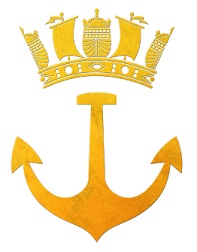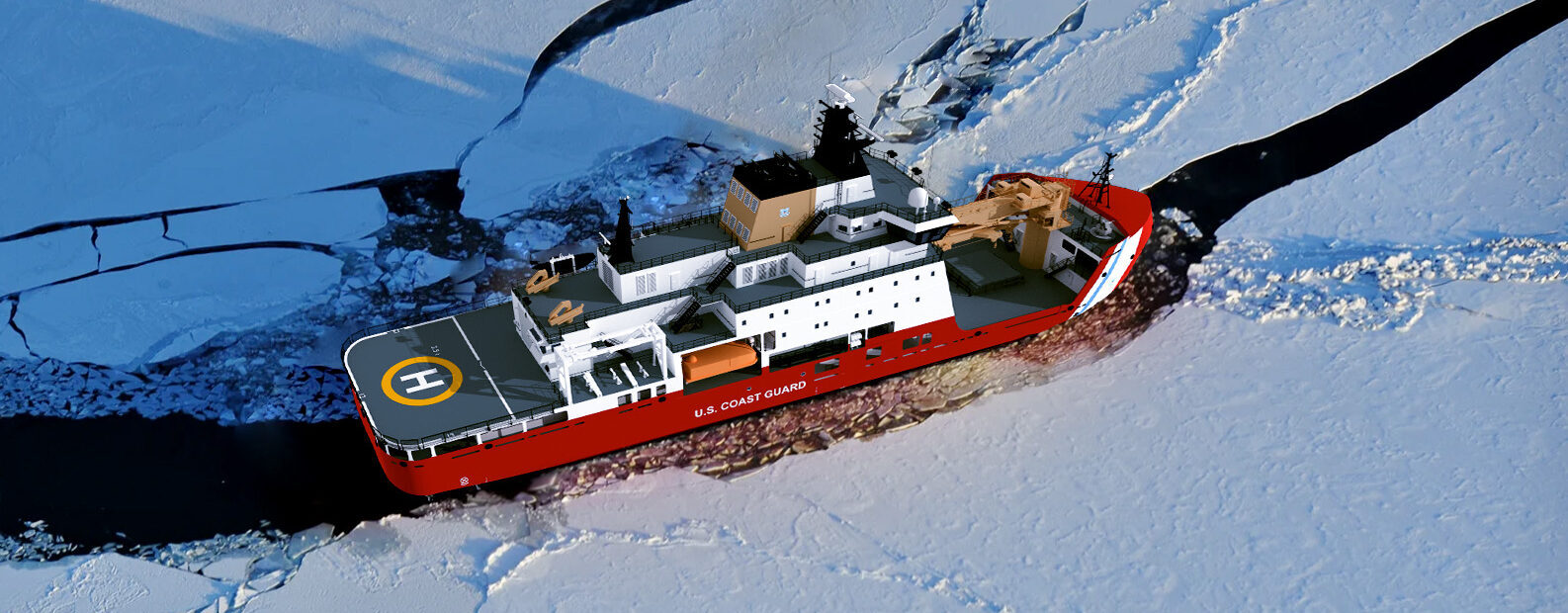By Mikaȅl Perron, 15 August 2025
In the recent announcement concerning Canada’s defence budget, it was revealed that the Canadian Coast Guard would move under the responsibility of the Department of National Defence. What will it mean in the future? There were no specific details released. I don’t believe that any armament will be fitted to the CCG fleet, but could some extra communication devices and sensors be eventually added to some ships? Would we see some RCN staff tagging along for some missions to operate and maintain such added equipment? I guess time will tell.
In the meantime, the construction of the first Polar Icebreaker as finally began at Seaspan in April, and the construction of the second one is soon to begin at Helsinki Shipyard in Finland and to be completed at Davie Shipyard later. These ships are crucial to Canada’s sovereignty claim to the Arctic and the control of our Exclusive Economic Zond (EEZ) up north. They are also crucial to our scientific exploration capability. The two ships represent the best icebreaker technology of the Western Hemisphere and are a major window for our shipbuilding industries.
[See Seaspan Polar Icebreaker: Polar Icebreaker - Seaspan and Davie Polar Icebreaker: Polar Icebreaker | Davie]
Also, at Davie Shipyard, some progress seems to have been made on the six strong class Program Icebreaker design. Some updated graphics appeared on their website lately. The specifics characteristics did not change but the new graphics revealed what seems to be an upscaled version of the CCG Multi-Purpose Vessel design (MPV) being built at Seaspan. The main configuration of the MPV is mainly driven by Aker Arctic under the ARC 146 design. Davie had originally proposed its own vision of the Program Icebreakers, but the CCG is probably driving to get its entire new fleet to be based on the world’s most advanced icebreaking technology which Aker Arctic are the forefront. [See Program Icebreaker: Program Icebreakers | Davie ]
The largest future class of large ships of the CCG will be delivered via the 16 strong ship MPV program. The aim is to replace multiple type of vessel with a single one. The ships being replaced are the OPV, High Endurance Multi-Tasked, and Medium Endurance Multi-Tasked vessels. It remains to be seen if the new design will meet the seakeeping qualities required to meet all these tasks. The government is proceeding with three flights and the first batch consists of six vessels. Future flights will incorporate lessons learned from the first one and should be adapted to other mission profiles. Most notably, at some point this year, the MPV program was rename MPI (Multi-Purpose Icebreaker) as can be seen on the Seaspan’s and GoC’s websites. The icebreaking attribute of the design are being put forward with this new designation. Is it for political reasons in order to show the extent of the future large fleet of icebreakers being operate by Canada or for foreign sales in order to sell a true icebreaker? In fact, these ships initially were tagged as having light icebreaking capabilities are now much larger than the ships they are replacing. They are now about the same size as the Type 1200 icebreakers actually operated by the CCG. The functional design now being complete, the program can move to production drawing. [See Seaspan MPI: Multi-Purpose Icebreakers - Seaspan]
Now, the ever-going-on fight of the Canadian shipyards is moving south of the border! After the ICE Pact agreement was announced early last year, Davie Shipyard quickly moved to acquire Helsinki Shipyard followed this year by Gulf Copper’s Texas Shipyards in the USA and Enersense Offshore in Finland. They are aiming at becoming the biggest builder of icebreakers in the world with shipyards in Finland, Canada and USA with the USCG icebreakers fleet renewal in mind. In a not so surprising move, Seaspan jumped into the dance of the USCG icebreaking fleet renewal in July. Seaspan announced a trilateral agreement with Finland and USA to propose an adapted version of the MPI for the new Arctic Security Cutter program announced in March. The program is to provide a new class of icebreaking cutter within 36 month of contract award. Seaspan is joining forces with Bollinger Shipyard of the USA (actually building the Polar Security Cutter), Rauma Shipyard of Finland and Aker Arctic to build an adapted version of the MPI for the USCG requirements (this could be why the MPV became the MPI!). The graphics on Seaspan website notably displays an MPI in USCG color schemes, a BAE Mk-38 gun mount on the starboard side of the forward crane. [See Seaspan Arctic Security Cutter: Seaspan Announces Strategic Trilateral Partnership with American and Finnish Allies to Deliver U.S. Coast Guard’s Arctic Security Cutter - Seaspan]
We can say that things are moving along quite well on the Canadian icebreaker building file. The expertise brought from Finland is definitely allowing both involved Canadian shipyards to make huge leaps forward that will be beneficial to the NSS and Canadian citizens’ money!
Image: A graphic of the Multipurpose Icebreaker variant proposed by Seaspan, Rauma, Bollinger, and Aker for the US Coast Guard's Arctic Security Cutter. Credit: Seaspan




5 thoughts on “Icebreaking Fleet Renewal Update”
The CCG has several armed vessels already. CCG Cape Roger, CCG Cygnus and Leonard J. Cowley are armed with .50 Cals for fisheries. They are expected to be replaced by the CCG variant of AOPV. Future builds will have better sensors and communications equipment so that info can be shared to increase the maritime picture. It’s not expected to have sailors in CCG ships. The CCG will move under the responsibility of DND however DND will have a hands off approach to the CCG. Otherwise not much change at all but enough to allow the CCG to count toward our NATO GDP.
Retired RCN,
I think you are bang on about the prime motivation behind the announced CCG-RCN merger being political – that is, the merger would allow Ottawa to count most of Canada’s expenditures on the CCG towards its renewed NATO spending pledges.
The announced merger, which apparently caught both the CCG and the RCN by surprise, might not amount to much in practical operational terms. Both CCG and DND officials have cautioned that any question of up-arming the two AOPS slated for the CCG is premature.
However, a recent ATI request indicated that a Briefing Note for an April 2025 meeting between representatives of the PCO, DND, Global Affairs Canada, and Fisheries and Oceans Canada had raised the possibility of changing the mandate of the CCG to strengthen Canada’s maritime security. This, in turn “may impact the need to arm some of its [CCG] personnel or fleet.” [See, John Woodside, “Canada considers arming Coast Guard as NATO pressure grows,” http://www.nationalobserver.com. https://www.nationalobserver.com/2025/08/18/news/coast-guard-canada-nato-arctic-security%5D
[See also, Christopher Nardi, “Liberals considering arming the Coast Guard amid significant pivot towards new security mandate,” National Post, 9 June 2025. https://nationalpost.com/news/canada/liberals-considering-arming-canadian-coast-guard%5D
It is important to note that this was only a Briefing Note, so we will have to await further developments to determine whether or not the CCG AOPS might eventually be armed with a gun similar to that on the RCN’s 6 AOPS.
The idea that Ottawa can simply fold the Canadian Coast Guard (CCG) into the Royal Canadian Navy (RCN), slap guns on their ships, and call it a NATO win is political fantasy that ignores hard realities.
In my own conversations with CCG employees, and from what I’ve seen on CCG chat forums, the reaction to these merger rumours is overwhelmingly negative. Many have made it clear that if Ottawa tries to arm their ships or force a quasi-naval mandate, they’ll quit. Others are already talking openly about labour action. The CCG is unionized, highly specialized and fiercely protective of its civilian identity. Ottawa can talk about ‘integration,’ but in practice it would bleed experienced operators right when they are needed most.
The CCG’s strength lies in its civilian neutrality. It can operate in environments where a naval presence would escalate tensions: icebreaking for commerce, search and rescue with the US Coast Guard, fisheries enforcement, or environmental response. Strip away that neutrality by arming the CCG, and Canada loses a key diplomatic and operational advantage. That is not a trade worth making.
Counting CCG dollars toward NATO’s 2% target sounds clever, but it won’t stand up to scrutiny. NATO’s rules are clear: ‘military’ expenditures count. Aids to navigation, icebreaking for commercial shipping, and pollution response are not defence activities. Allies won’t accept Canada padding its books by militarizing civilian services.
The two Arctic and Offshore Patrol Ships destined for the CCG are being built without deck reinforcement for a naval gun mount, and without space for a magazine to safely store 25mm ammunition. In other words: they cannot simply be armed like their RCN sisters. Retrofitting would mean major, costly structural changes — far beyond ‘plug and play.’ Ottawa knows this, which is why both DND and CCG leadership quickly poured cold water on the idea when the story broke.
The notion that Canada can militarize the Coast Guard cheaply and seamlessly is both politically and technically naïve. The workforce won’t tolerate it, the ships aren’t designed for it, and NATO won’t buy it. Based on what I’ve seen directly from CCG personnel, any attempt to arm or amalgamate will cause resignations, labour disputes and the loss of Canada’s most effective maritime tool: a respected, neutral Coast Guard that can operate where navies cannot.
Well said!
This merger idea also ignores Canadian history. By my count, the notion that the CCG could be folded somehow into the RCN has been explored at least 7 times, dating back to 1962.
In trying to fudge the books, Ottawa would not be alone. Many European NATO members have long been counting some of their major infrastructure, like highways and railways, as ‘military mobility’ expenditures towards their NATO spending targets.
For several years now, Ottawa has been trying to expand its definition of NATO expenditures to include monies spent by about a dozen federal departments and agencies. I expect Ottawa to be even more creative if it sticks to its pledge to increase defence expenditures well beyond 2% of GDP.
It now seems like both Seaspan and Davie achieved success in their USA endeavour. Although no ships will be built in Canada, Seaspan MPI design will be built in Finland and USA. Also Davie will be building Icebreakers in its Helsinki and Texas facilities. See the link here for more details.
https://sixtydegreesnorth.substack.com/p/usa-finland-icebreaker-deal-announcement